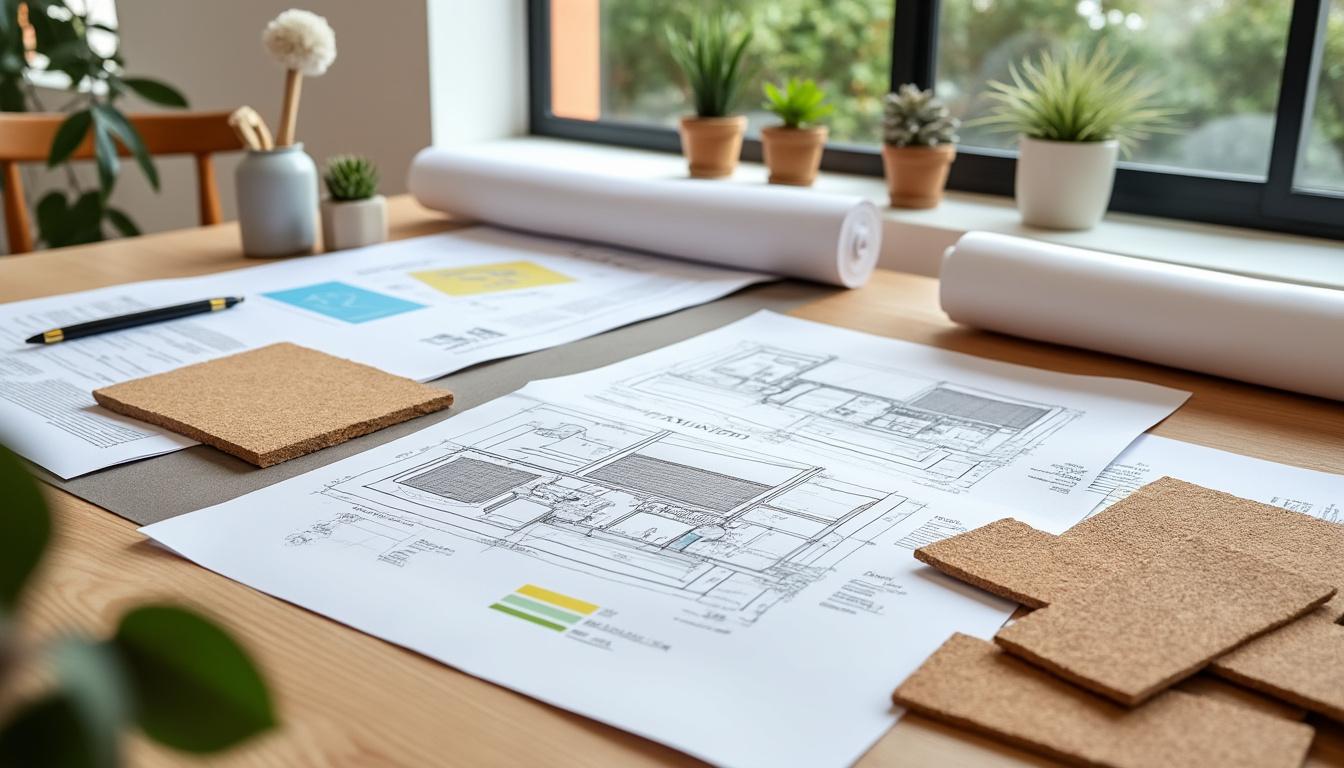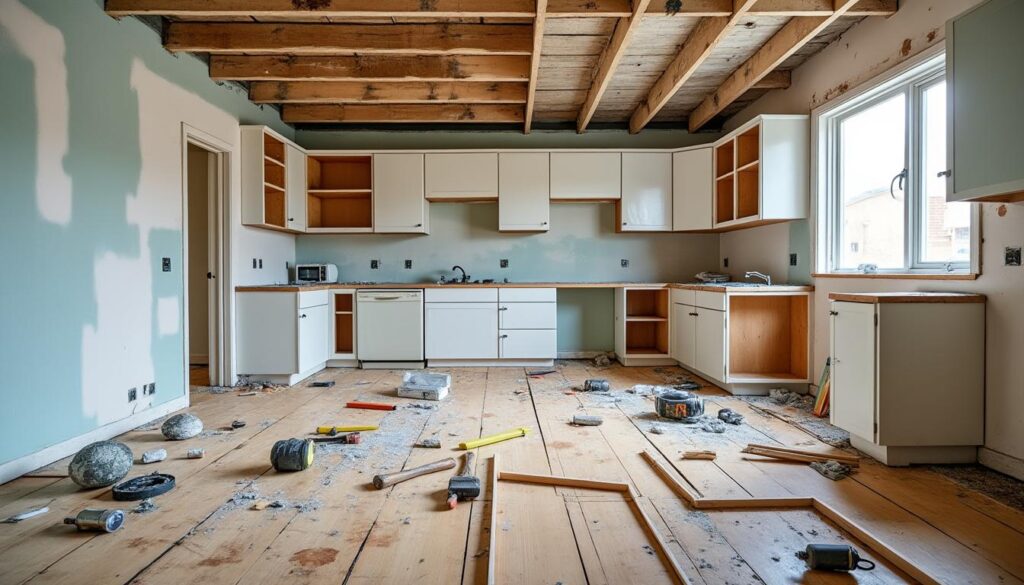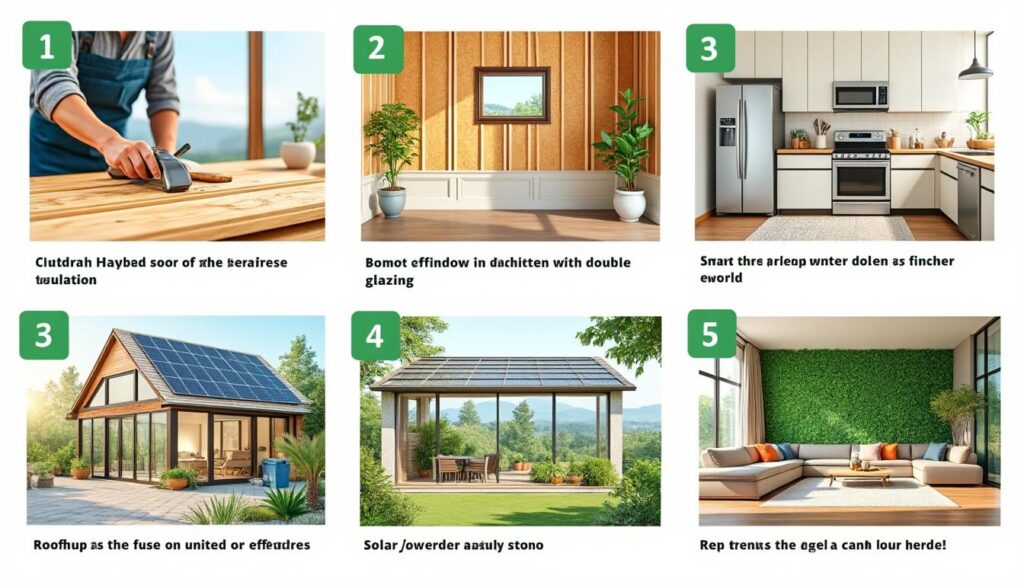Renovating with savings and without losing quality is entirely possible when combining method, smart choices, and focus on what truly brings value. Below is a clear path to guide each step with efficiency and environmental responsibility.
Short on time? Here’s the essential:
| ✅ Key points ⚡ | What to do 🛠️ | Why it matters 💡 |
|---|---|---|
| Detailed planning | Map needs, priorities, and budget limitations | Fewer surprises and more control over timeline and cost |
| Cost-effective materials | Compare suppliers and assess performance/lifespan | Real savings without compromising durability |
| Qualified labor | Hire based on scope with deliverables and guarantees | Avoids rework and hidden costs |
| Preventive maintenance | Construction details that protect the investment | Increases lifespan and reduces future costs |
| Negotiation and partnerships | Plan purchases, compare proposals, and secure packages | Better prices, deadlines, and conditions 🧾 |
Detailed planning for an economical renovation without compromising quality
A clear plan is the best protection for your budget. Before any decisions are made, it’s worth translating desires into requirements and listing what is indispensable, what is desirable, and what can wait.
Imagine the Martins family, who intend to renovate a T2 in Porto. They map leaks, electrical failures, and energy waste, and then set goals: thermal comfort, low consumption, and timeless aesthetics.
Property diagnosis and priorities focusing on the essentials
An objective technical diagnosis avoids surprises and guides priorities. Start with structure, humidity, electrical, and plumbing. Thermal and acoustic comfort follow since they impact health and the energy bill.
In practice, fixing a leak before painting prevents the finish from deteriorating in a few weeks. Organizing by risks and impact helps decide where to invest first.
- 🧭 Initial checklist: structure, humidity, networks, window frames, insulation, ventilation.
- 🎯 Priorities by impact: safety > energy efficiency > comfort > aesthetics.
- 🧮 Budget by ranges: minimum viable, recommended, and optimized.
- 📆 Executable phases: dividing the work into stages reduces stoppages and costs.
Budget by scenarios and lean schedule
Budgeting by scenarios allows progress without halting everything for an expensive item. A “lean” schedule chains the right tasks at the right time, reducing idle time for teams.
In the Martins’ project, window replacement was phase 2, as phase 1 focused on correcting humidity and ceiling insulation, with payback in heating in the first winter.
| Phase 🧩 | Main scope 🔍 | Cost target 💶 | Immediate benefit ✅ |
|---|---|---|---|
| 1 | Humidity correction and ceiling insulation | € 2,000–€ 3,000 | Thermal comfort and protection of the finish |
| 2 | Electrical review and efficient LED | € 1,200–€ 1,800 | Safety and reduced energy bill ⚡ |
| 3 | High performance windows | € 3,500–€ 5,000 | Less noise and thermal losses |
| 4 | Finishes and functional carpentry | € 2,000–€ 4,000 | Durable aesthetics and space organization 🗂️ |
A good plan is not rigid; it guides decisions without trapping. The next step is to choose materials with the best performance per euro invested.

Sustainable and inexpensive materials: how to choose without losing quality
Materials define performance, maintenance, and comfort. Opting for solutions with good durability and low maintenance is the most effective way to save over the life cycle.
Comparing suppliers, requesting samples, and checking technical sheets avoids regrets. Products with Environmental Product Declaration (EPD) help to measure real impact.
Smart substitutions that maintain performance
There are choices that reduce costs while maintaining results. Hollow polycarbonate, for example, replaces glass in covers for service areas with great strength and low weight.
Mineral silicate paint can last longer on interior walls, with low VOC emissions, which improves indoor air quality and reduces repainting.
- 🔁 Coatings: rectified ceramic instead of premium porcelain when traffic is moderate.
- 🪟 Window frames: double glazing with PVC or laminated wood frames as an alternative to premium aluminum.
- 🧱 Insulation: cork and recycled cellulose provide thermal performance with a low footprint.
- 🧴 Finishes: eco-friendly paints with high washability and low odor.
Reuse, standardize, and purchase wisely
Reusing solid doors with new hardware, restoring hardwood floors with sanding and natural oil, and standardizing measurements reduce waste.
Purchasing in bulk, package negotiations, and attention to delivery times keep the work flowing and avoid last-minute costs.
| Material 🧱 | Approx. cost €/m² 💶 | Service life ⏳ | Maintenance 🧰 | Environmental impact 🌿 |
|---|---|---|---|---|
| Cork for insulation | € 15–€ 25 | 20–30 years | Low | Renewable, low embedded energy |
| Hollow polycarbonate | € 18–€ 30 | 15–20 years | Medium | Light, reduces structure, recyclable ♻️ |
| Rectified ceramics | € 12–€ 22 | 15–25 years | Low | Durable, low maintenance |
| Mineral paint (silicate) | € 4–€ 8 | 10+ years | Low | Low VOC, good vapor diffusion 💨 |
The right materials protect your budget and the planet. If video support is useful, it’s worth exploring practical references on material selection and performance.
With inputs defined, the next step is to ensure quality execution with efficient project management.
Qualified labor and efficient management: less rework, more savings
Experienced professionals cost a bit more at the beginning, but they deliver precision, meet deadlines, and avoid expensive errors. The cheap that becomes expensive is almost always the result of a lack of method.
Defining clear scopes, hiring based on deliverables, and maintaining inspection routines creates transparency and reduces conflicts.
Hiring by scope and using quality checklists
Scope contracts, with payment milestones tied to results, align expectations and protect your investment. Standardized checklists in each phase prevent forgetfulness.
In the case of the Martins’, painting only began after the formal “ok” on the humidity corrections, ensuring adherence and durability of the finish.
- 📋 Phase checklists: demolition, infrastructure, thermal enveloping, finishes.
- 🧪 Quick tests: airtightness of window frames and thermal checks with an infrared thermometer.
- 👷 Defined responsibilities: one project leader and one contact point for questions.
- 🧾 Photo documentation: before/after and intermediate stages to prove deliveries.
Weekly inspections and risk management
A short weekly meeting, lasting 30 minutes, resolves 80% of problems before they become delays. In it, deadlines, critical materials, and scope adjustments are checked.
Simple tools, such as a physical Kanban board, help keep teams coordinated and maintain a continuous flow.
| Management item 🧭 | Good practice ✅ | Cost savings 💶 |
|---|---|---|
| Scope contract | Payments by milestones and minimum guarantee of 12 months | Avoids costly amendments and rework |
| Phase checklist | Signature of the technical responsible | More control and fewer errors ⚙️ |
| Weekly meeting | 30 min with a visible action plan | Anticipation of risks and delays |
| Photo documentation | Evidence of execution and quality | Basis for warranty and audit 🔍 |
Executing well is half the battle. The other half is ensuring that your home remains efficient for many years with planned maintenance from the outset.

Preventive maintenance from the project: save today and tomorrow
Planning maintenance even in the design of the renovation reduces future costs and increases lifespan. The choice of details that facilitate cleaning, inspection, and replacement is crucial.
Removable grilles, easily accessible baseboards for passing cables, and siphons with quick inspection are small gestures that, when combined, generate significant savings.
Construction details that prevent pathologies
Breathable finishes on walls prone to condensation help prevent mold. Proper sealants at joints between materials reduce leaks.
Cross ventilation and exhaust in humid areas reduce moisture and protect coverings, which avoids recurring repairs.
- 💨 Controlled ventilation: exhaust fans with timers in bathrooms and kitchens.
- 🧱 Baseboard detail: profiles that slightly elevate the finish of the floor against water.
- 🪟 Proper seals: neutral or hybrid silicone in critical areas.
- 🔧 Accessible components: inspection of siphons, valves, and junction boxes.
Annual inspection plan and predictable costs
Establishing a verification calendar simplifies household management. A brief, but regular, look identifies early signs and allows for quick and inexpensive corrections.
In the Martins’ apartment, a biannual inspection of window frames and shower seals avoided stains and costly repairs.
| Element 🏠 | Frequency ⏱️ | Preventive action 🧰 | Approx. annual cost 💶 |
|---|---|---|---|
| Window frames and seals | Biannually | Tightening hinges and replacing rubber when necessary | € 40–€ 80 |
| Exhaust fans and grilles | Quarterly | Filter cleaning and flow verification | € 20–€ 40 |
| Bathroom seals | Annually | Inspection and silicone replacement | € 30–€ 60 |
| Painting in humid areas | Biennially | Touch-ups with breathable mineral paint | € 50–€ 120 🎯 |
To delve into preventive maintenance strategies and avoid rework, it’s worth consulting technical content and practical demonstrations.
With the property protected by well-thought-out details, the last piece of the puzzle is to negotiate intelligently for each purchase and service.
Smart negotiation and conscious financing: maximize investment in an economical renovation
Negotiating is not just asking for a discount; it is building mutually beneficial relationships with fair deadlines, clear guarantees, and delivered quality. Planning and data strengthen your position.
Closed packages (materials + installation), comparable proposals, and defining acceptable brands create predictability and avoid impulse choices.
Practical negotiation strategies with suppliers and teams
Request three comparable quotes, with the same scope and specifications. Show the project planning and payment predictability.
Anticipate critical purchases (windows, insulation, fixtures) and request phased payment terms. Loyal partnerships often yield bonuses and shorter delivery times.
- 🧾 Comparability: same brand/model/quantity among proposals.
- 📦 Packages: close lots with installation to reduce risks.
- 💳 Conditions: negotiate deadlines and retention of 5–10% until final delivery.
- 🛡️ Warranty: request terms in writing and technical assistance.
TCO (total cost of ownership) and efficiency incentives
Looking only at the purchase price is misleading. TCO includes maintenance, energy consumption, and replacements. Over 3–5 years, better windows and adequate insulation usually pay the difference.
Check for active local energy efficiency programs in 2025 that support thermal upgrades, efficient lighting, and low-consumption ventilation. By combining incentives with strategic purchases, the return accelerates.
| Negotiated item 🤝 | Applied tactic 🧠 | Expected outcome 📈 | Reduced risk 🛡️ |
|---|---|---|---|
| High performance windows | Advance purchase + package with installation | Lower price and guaranteed delivery | Fewer delays and rework |
| LED lighting | Compare brands with extended warranty | Lower TCO and easier replacement | Early failures covered 🔌 |
| Thermal insulation | Volume negotiation | Progressive discount | Proper stock and timeline met |
| Specialized labor | Delivery milestones + 5–10% retention | Consistent quality | Effective warranty 🧰 |
If you want to delve into good purchasing practices and contracts, there are useful contents and case studies available on reference platforms like Ecopassivehouses.pt, with ideas that clarify choices and avoid unnecessary expenses.
Immediate action: list today 3 technical priorities and 3 material choices that deliver energy savings. Request three comparable proposals for each. This simple movement unlocks decisions with confidence.
{“@context”:”https://schema.org”,”@type”:”FAQPage”,”mainEntity”:[{“@type”:”Question”,”name”:”How to prevent the budget from bursting during the renovation?”,”acceptedAnswer”:{“@type”:”Answer”,”text”:”Define closed scopes by phase, use a lean schedule, and create a technical reserve of 10–15% for unexpected costs. Pay by completed milestones and validate each stage with a checklist signed by the technical manager.”}},{“@type”:”Question”,”name”:”Which materials offer good cost-benefit without compromising quality?”,”acceptedAnswer”:{“@type”:”Answer”,”text”:”Cork insulation, rectified ceramics in moderate traffic areas, low VOC mineral paint, and hollow polycarbonate for wet area roofs. Compare performance, lifespan, and maintenance before deciding.”}},{“@type”:”Question”,”name”:”Is more expensive labor worth it?”,”acceptedAnswer”:{“@type”:”Answer”,”text”:”Yes, when the contract is by scope with guarantees. Qualified professionals reduce rework, meet deadlines, and make the project more predictable, which translates into savings overall.”}},{“@type”:”Question”,”name”:”What to include in a preventive maintenance plan?”,”acceptedAnswer”:{“@type”:”Answer”,”text”:”Biannual inspections of window frames and seals, quarterly cleaning of exhaust fans, annual seal reviews, and biennial touch-ups with breathable paint in humid areas. Everything cataloged in a simple calendar.”}},{“@type”:”Question”,”name”:”How to negotiate better with suppliers?”,”acceptedAnswer”:{“@type”:”Answer”,”text”:”Request three comparable proposals, close packages with installation, negotiate timelines and retention of 5–10%, and request guarantees in writing. Anticipating critical purchases improves price and availability.”}}]}How to prevent the budget from bursting during the renovation?
Define closed scopes by phase, use a lean schedule, and create a technical reserve of 10–15% for unexpected costs. Pay by completed milestones and validate each stage with a checklist signed by the technical manager.
Which materials offer good cost-benefit without compromising quality?
Cork insulation, rectified ceramics in moderate traffic areas, low VOC mineral paint, and hollow polycarbonate for wet area roofs. Compare performance, lifespan, and maintenance before deciding.
Is more expensive labor worth it?
Yes, when the contract is by scope with guarantees. Qualified professionals reduce rework, meet deadlines, and make the project more predictable, which translates into savings overall.
What to include in a preventive maintenance plan?
Biannual inspections of window frames and seals, quarterly cleaning of exhaust fans, annual seal reviews, and biennial touch-ups with breathable paint in humid areas. Everything cataloged in a simple calendar.
How to negotiate better with suppliers?
Request three comparable proposals, close packages with installation, negotiate timelines and retention of 5–10%, and request guarantees in writing. Anticipating critical purchases improves price and availability.


